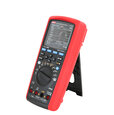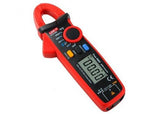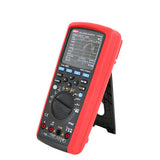What is a Clamp Meter
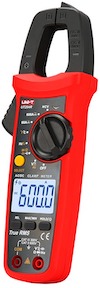
Figure 1: Clamp meter
A clamp meter can measure the current flowing through a conductor without touching it. This device has a hinged jaw integrated into an electrical meter. The jaw clamps around a conductor in an electrical system while current flows through it. Therefore, there is no loss of power or damage in the circuit during measurements, and it protects a user from being electrocuted. A clamp meter is typically used to measure high-level currents, troubleshoot installation problems, and conduct circuit tests. Common applications are industrial equipment and control systems, HVAC, and residential electrical systems.
Table of contents
- Types of clamp meters
- Working principle
- How to use a clamp meter
- Advantages and disadvantages of a clamp meter
- Clamp meter vs multimeter
- FAQs
View our online selection of clamp meters and multimeters!
Types of clamp meters
- AC clamp meter: AC clamp meters measure alternating current only.
- Hall effect clamp meter: Hall effect clamp meters, also known as AC/DC clamp meters, can measure both alternating current (AC) and direct current (DC).
- Flexible clamp meters: The flexible type uses a Rogowski coil to measure only AC.
Working principle
Alternating current (AC) clamp meters
The clamps on a clamp meter are also called tongs, which is why these devices are also called tong testers. The tongs of an AC clamp meter (Figure 2 right) contain a current transformer, which is a coil of wire wrapped around a ferrous metal, making it a magnetic core. When the clamp meter's tongs go around the wire carrying AC, the clamp's magnetic core generates a secondary magnetic field.
AC reverses polarity frequently, which creates a magnetic flux. According to Faraday's law of electromagnetic induction, a change in the magnetic field induces an electric current in the coil. The magnitude of the current induced in the clamp meter's coil is proportional to the current flowing through the wire. The current induced in the coil is displayed on the meter's digital display (in the case of a digital clamp meter), usually in amperes.
AC clamp meters cannot measure DC. The magnetic fields generated by DC do not fluctuate, so a current transformer cannot detect them. See the next section to determine which clamp meters can measure DC and how they do it.
Hall-effect clamp meters (AC/DC clamp meters)
An AC/DC, or hall effect, clamp meter (Figure 2 left) can measure direct current:
- A current-carrying conductor produces a magnetic field around its surface.
- A hall effect sensor is mounted within the closed loop (created when the clamps shut) around the conductor.
- The magnetic field the current-carrying conductor produces is sensed by the hall effect sensor, and a small voltage is produced across the sensor.
- A hall effect sensor is a transducer that produces an output voltage proportional to the magnetic field at its input.
- The output voltage can be amplified and measured.
Hall effect clamp meters can be used to measure AC as well. These clamp meters use more sophisticated technology for measurements, so they cost more than AC clamp meters.
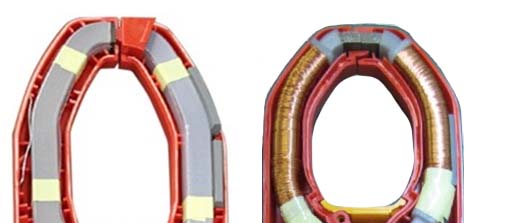
Figure 2: A sensor sits in the air gap between the jaws of hall effect clamp meters (left) and the tongs of AC clamp meter(right).
Flexible clamp meters
A flexible clamp meter works similarly to an AC clamp meter. However, the clamp is a wire instead of tongs. It can be opened and wrapped around the current-carrying conductor. This allows a flexible clamp meter to measure AC in tight or difficult-to-reach places.
How to use a clamp meter
Whether using an AC clamp meter or a hall effect clamp meter, the general use is the same:
- Push the lever on the meter's side to open the tongs.
- Position the tongs to wrap around the current-carrying conductor, then close them.
- Note the current reading on the meter's display.
When measuring DC, pay attention to the following when using an AC/DC clamp meter:
- The meter's dial is set to measure DC instead of AC.
- Reset the meter before measuring DC because the Earth's magnetic field can impact the reading.
For an in-depth understanding on different ways to use a clamp meter, read our article on how to use a clamp meter.
Advantages and disadvantages of a clamp meter
Advantages
- Non-invasive measurement: Clamp meters do not require the disconnecting of the circuit.
- Easy to use: Clamp meters have a simple operation and display their readings on a digital screen.
- Versatile: AC/DC clamp meters can measure both types of currents, as well as voltage, resistance, and continuity.
Disadvantage
- Limited range: Clamp meters can only measure up to a few hundred amps.
- Interference: Clamp meter accuracy can be affected by electromagnetic interference (EMI) or radio frequency interference (RFI).
- Cost: High-quality clamp meters are expensive and not suitable for infrequent use.
- Accuracy: The accuracy of the readings produced by a clamp meter is lower when compared to other measurement devices like a multimeter.
Clamp meter vs multimeter
- Measurement functions: A clamp meter measures AC and DC. A multimeter can measure voltage, current, and resistance.
- Precision: If both are the same brand, the multimeter will be more precise than the clamp meter.
- Versatility: Clamp meters are easier to use when measuring live currents. A user simply opens the jaws and closes them around the conductor. A multimeter has test probes that must be placed on two terminals of the conductor.
Learn more by reading our clamp meter vs multimeter article.
FAQs
How to use a clamp meter to measure AC current?
Open the electrical clamp meter's tongs and close them around the current-carrying conductor (e.g., the wire).
Is a clamp meter as precise as a multimeter?
The difference in precision between a multimeter and clamp meter can be brand dependent. However, typically a multimeter is more precise than a clamp meter.





